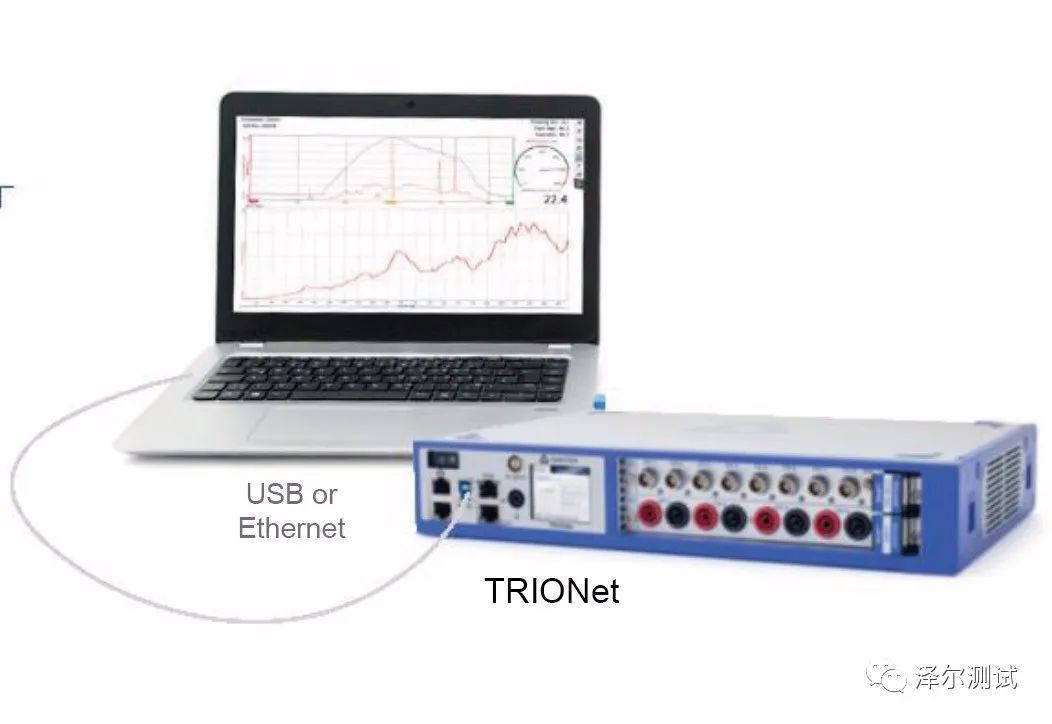
Abstract: In order to obtain the energy consumption law of electric vehicles under static conditions, this paper designs the energy consumption decay test of electric vehicles at room temperature, the comparison test of high and low temperature energy consumption, and the energy consumption distribution test of the low-voltage system in the vehicle. The external environment of energy consumption and internal electrical equipment are analyzed in detail. The results show that in the range of -7~25℃, the influence of static temperature on the decay rate of energy consumption is negligible, and it shows that the driving range increases with the static temperature. The extension of the set-up time shows a linear downward trend; reducing the static energy consumption of the low-voltage system of the electric vehicle can effectively reduce the decay speed of the vehicle's displayed driving range. It provides a reference for the field of vehicle energy consumption.
As one of the core technical indicators of electric vehicles, energy consumption is the main reason for consumers' mileage anxiety. The driving range and energy consumption of electric vehicles based on various scenarios have become the key research areas of various research institutions and automobile manufacturers. However, the characteristic analysis of the energy consumption of electric vehicles in the stationary state mainly focuses on the battery level, and the analysis and research on the stationary energy consumption of the whole vehicle are rarely seen; Mainly, no studies on longer time scales have been seen. Therefore, this paper studies the energy consumption of electric vehicles under different standing time and standing temperatures, formulates test methods at the vehicle level and component level, and analyzes the influencing factors and changing laws of electric vehicle standing energy consumption. , laying a foundation for the vehicle enterprises to further optimize the vehicle energy consumption system.
1. Cause analysis and experimental design of stationary energy consumption of electric vehicles
The energy consumption of an electric vehicle under stationary conditions consists of 3 components:
1) The self-discharge characteristics of the power battery and the storage battery system and the dark current of the electronic equipment lead to a decrease in the battery power;
2) In order to ensure the safe use of electric vehicles, the on-board terminals installed in electric vehicles need to regularly store and report the safety status of the vehicle and the status of the power battery, resulting in constant power consumption;
3) In order to improve customer experience, electric vehicles are generally equipped with users
User-friendly configurations such as APP and welcome function require the related controllers to be always on, resulting in power consumption. In order to solve the problem of static energy consumption, most of the current electric vehicles are equipped with an active charging control strategy of remote high-voltage power supply to ensure the reliability of the low-voltage power supply system of electric vehicles. The static energy consumption of electric vehicles is relatively complex, and the working current is a microcurrent that is difficult to measure. In the research process of the article, the following
There are 2 ways to carry out the test work:
1) After standing for a period of time in a fully charged state, AC charge the vehicle, and evaluate the energy consumption during the standing process as a whole by the amount of charge;
2) Real-time monitoring of the low-voltage circuits of electric vehicles, and measurement of the quiescent current of the main electrical equipment to evaluate the energy consumption level of each electrical equipment.
2. Introduction of test equipment
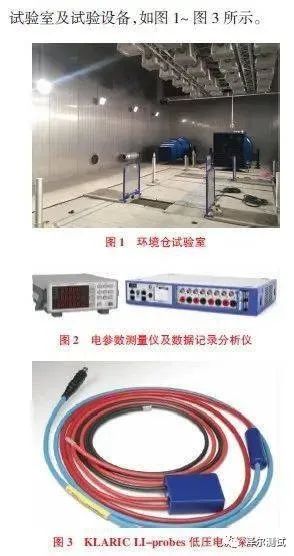
3. Analysis of test results
3.1 Analysis of the change law of static energy consumption
Referring to the GB/T18386-2017 test method, after the electric vehicle is fully charged (220V AC), it is left to stand in a laboratory with an ambient temperature of (25±5) °C, and the driving mileage attenuation value displayed by the vehicle instrument is recorded every 24 hours, as Reference for driving range decay. After standing for 144 hours, the car was charged again with 220V alternating current, and the electricity value was recorded as the basis for evaluating the standing energy consumption of the electric vehicle. Figure 4 shows the variation law of the displayed driving range of the five vehicles with the resting time.

The test was carried out in a vehicle laboratory with an environmental chamber, a four-wheel-drive chassis dynamometer, an electrical parameter measuring instrument, a data recording analyzer, and a low-voltage current probe. The test equipment is shown in Table 1.
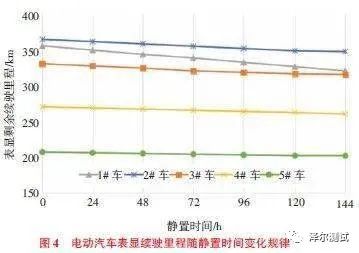
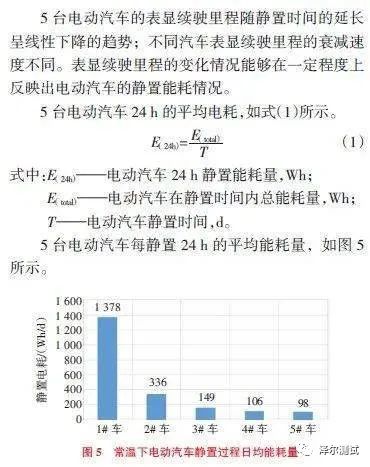
It can be seen from the figure that the static energy consumption of different electric vehicles varies greatly, among which the static energy consumption level of the 1# vehicle is 8 times the average level of the other 4 vehicles; In addition to the static energy consumption, it is also related to the energy management strategy of the vehicle and the static energy consumption level of the electrical equipment.
In order to investigate the actual impact of electric vehicle static energy consumption on the driving range, the 1# and 2# electric vehicles were subjected to the normal temperature driving range test under the Chinese working condition (CLTC-P) after the 1# and 2# electric vehicles were fully charged for 144 hours. For example, as shown in Table 2.

It can be seen from Table 2 that the displayed driving range attenuation and the driving range attenuation calculated according to the static energy consumption and working condition energy consumption are basically the same as the actual driving range attenuation value of the vehicle, which shows that the experimental design and evaluation method are reasonable. sex.
3.2 Analysis of the effect of static temperature on static power consumption
Five identical electric vehicles were left for 24 hours at (25 ± 5) ℃ and (-7 ± 3) ℃ respectively in a fully charged state, and the power was recharged at room temperature, and the charging power was recorded. The results are as follows shown in Figure 6.
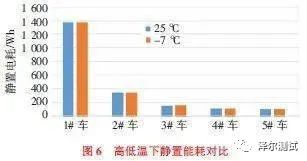
It can be seen from Figure 6 that the difference in energy consumption of standing for 24 hours at high and low temperature is very small, all below 1%. It can be seen that in the range of -7~25 °C, the effect of temperature on the standing energy consumption of electric vehicles is relatively small. small, almost negligible.
3.3 Power consumption analysis of low-voltage system of stationary electric vehicle
In the static energy consumption of electric vehicles, the phenomenon of voltage drop and capacity reduction caused by the self-discharge characteristics of power batteries and battery systems is one of the main parameters to measure battery performance. The self-discharge rate of lithium-ion batteries is 2 per month. %; from the static energy consumption results of 5 electric vehicles, the average monthly battery state of charge (SOC) decreased by 25%, and the SOC decrease caused by the self-discharge characteristics of the battery accounted for 8%; The safety of the use of the car and the improvement of the customer experience require that the related controller is always on, which leads to the consumption of electric energy accounting for more than 92%, and this part of the energy consumption is provided by the low-voltage power supply system of the electric vehicle. The article selects the higher static energy consumption The energy consumption of each electrical equipment in the low-voltage system was measured for the 1# vehicle.
During the test, KLARICLI-probes low-voltage current probe and DEWETRONTRIONet recording analyzer were used to measure the stationary current of the vehicle, and the fuse was pulled out from the vehicle fuse box and the current probe was connected in series to measure, as shown in Figure 7 .
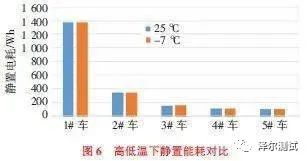
In the process of vehicle static current test, a current sensor is connected to the negative electrode of the battery, and the change of the current flowing through the negative electrode of the battery after the vehicle is locked is collected by a data acquisition device. Finally, the current value after the vehicle enters the sleep state is the vehicle quiescent current.
There are 2 types of situations during the controller quiescent current test:
1) For the fuse with only one controller mounted on its line, directly connect a current sensor in series to the fuse of the loop to measure, collect a period of time and take the time average as the static current value of the controller;
2) For the insurance with multiple controllers mounted on the line, after the vehicle enters the sleep state, from the complete state, press the controller list, unplug the connectors of the controllers one by one, and each controller collects a period of time and takes the time. Average value, the variation of the average current before and after is the quiescent current value of the controller.
After the implementation is completed, the quiescent current value of each electrical equipment in the low-voltage system is sorted out. A total of 44 electrical equipment have quiescent current, and the electrical equipment and current value with quiescent current greater than 1 mA are shown in Table 3.
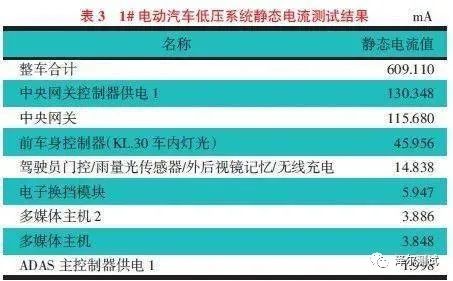
At the same time, the low-voltage system power consumption test is carried out on the 5# electric vehicle with small static power consumption, and the electrical equipment and current value with static current greater than 1mA are shown in Table 4.
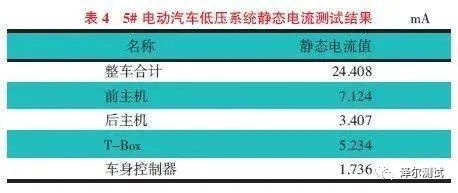
Judging from the static current of the battery, the static current of the 1# car is about 25 times that of the 5# car, which proves that the static power consumption of the 1# car is relatively large. Relevant studies have shown that due to the increase of advanced automotive electrical equipment, its quiescent current also increases. It is generally considered that the quiescent current below 50mA is normal. Excessive quiescent current can easily cause the battery to lose power. If there is no high-voltage charging strategy, it is easy to cause the car to fail to start normally.
4 Conclusion
The driving range attenuation caused by the stationary energy consumption of electric vehicles decreases linearly, and the attenuation speed is less affected by the temperature (-7~25℃). It can effectively reduce the decay speed of the standing driving range and relieve the anxiety of consumers that they cannot start due to long-term standing. Since it takes 3 months or even longer for the whole vehicle to be fully discharged, it is uncertain whether there is a sudden change in the energy consumption of the whole vehicle in the low power storage state, and further research is needed. In addition, the article only studies the attenuation of energy consumption under constant temperature. Whether the rapid temperature change in a short period of time will cause the attenuation to accelerate, it needs further verification.